As a groundbreaking critical and commercial success that has now been around for five decades as of this year, I did not think there was anything else to learn about Jaws that I did not know already. Well, as it turns out, I’m gonna need a bigger brain to hold all the fascinating trivia I recently discovered from a new documentary about the greatest shark movie ever made.
Included on the film’s recently released 50th anniversary Blu-ray set is Jaws @ 50: The Definitive Inside Story, a deep dive into the making of and enduring legacy of Steven Spielberg’s 1975 blockbuster, which is set to air on National Geographic on July 10th and will be available to stream with a Hulu subscription the next day. There are plenty of awesome facts you can bite into then, but for now, here’s a sneak peek at the revelations from the doc that had my jaw on the floor.

How Jaws’ Terrifying Opening Scene Was Achieved
John Williams’ Oscar-winning score, which Steven Spielberg almost rejected – is that the shark remains unseen for almost the first two-thirds. However, that was an impromptu decision enforced by the mechanical Great White’s constant technical difficulties, as the creature was originally meant to appear much earlier. In fact, it was supposed to appear in the opening scene.
THR), the film’s terrifying opening scene shows the young woman being violently thrashed about by something under the surface, which turned out to be a pretty simple effect. Blacklinie was put into a harness and then pulled from side to side by submerged crew members.
his second feature, The Sugarland Express, and asked her to do the same for the creature feature. In fact, outside of the main players, including Roy Scheider, Richard Dreyfuss, and Robert Shaw, most of the actors you see in Jaws are average townspeople who were essentially pulled from the streets of Martha’s Vineyard, which doubled as Amity Island.
movie based on a popular novel of the same name by Peter Benchley, who also co-wrote the screenplay with Carl Gottlieb. The author also appears in Jaws @ 50 through archival footage, in which he describes his favorite “review” of the book, which may be my favorite bit of Jaws trivia I have learned so far. I’ll let Benchley describe it for you in the following quote:
Frank Mankiewicz was interviewing Fidel Castro and asking, ‘What do you read?’ And Castro said, ‘Well, most recently, I’ve read a book called Tiburon,’ and Mankiewicz said, ‘Why are you reading commercial American thrillers?’ And Castro said, ‘Ah, no, you’re wrong. This is not a commercial American thriller. This is a marvelous metaphor about the corruption of capitalism.’
Leave it to a controversial political figure like the then-president of Cuba to pick up on one of the most essential lessons of Jaws (which was published as Tiburon in Spanish-speaking countries). Of course, its underlying economic commentary has become more widely recognized today as more people have realized the story’s true villain is Mayor Larry Vaughn (Murray Hamilton), who greedily downplays the severity of Amity’s shark problem. Benchley also mentions that he tried to get an ad printed with Castro’s quote, but his publisher would not allow it.
Hollywood production that would make for one fascinating biopic, from the shark’s aforementioned technical problems to Dreyfuss and Shaw’s feud. Even after the film became a record-breaking phenomenon, the incessant issues the cast and crew experienced on set had no greater effect on anyone than Steven Spielberg, who described the process of making the film as a life-changing experience, in good ways and in bad.
In Jaws @ 50, the legendary, Academy Award-winning filmmaker reveals that, after spending so much time trying not to break under pressure from the problems he and the crew faced, the stress he kept bottled up finally imploded once the cameras stopped rolling and the job was finally done, and he underwent what he descibes as a “full-blown panic attack.” He goes on to say that, for years, he would sneak onto the Universal Studios tour’s display of the Orca just to be alone and cry, which served as his own method of recovering from the taxing shoot.
best horror movies of all time, Jaws does not necessarily have a squeaky clean reputation, and I am not referring to its widely reviled sequels. I am referring to the number of innocent shark lives that the success of the film indirectly cost.
Jaws @ 50 touches on the fact that, after the film came out, the rate of shark hunting shot up exponentially, with many people seeking to kill the marine creatures purely for sport. Jaws is often remembered as a film that made people afraid to enter the water, yet it looks like that was not entirely the case, but in a largely negative way.
I hate to end this retrospective of one of the finest films of all time on a somber note, so let’s end it on a celebratory note. Hollywood’s first blockbuster is 50 years old, and that is enough of a reason to smile, you son of a…
